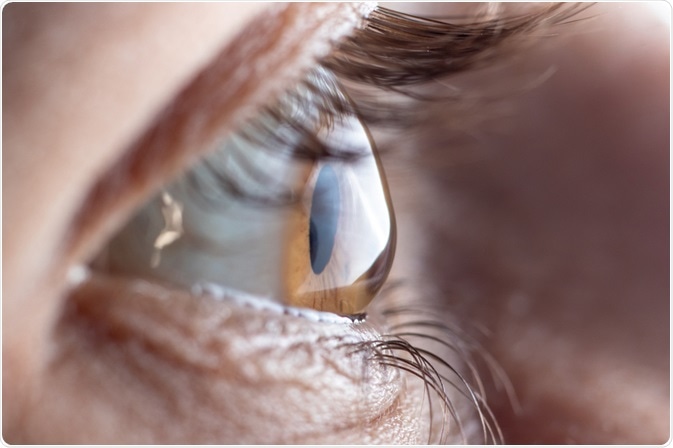Astigmatism is a term that refers to an imperfection in the shape of the cornea. Rather than being a clear, round dome to cover the iris and the pupil of the eye in an even curved shape, the surface of the cornea is irregular and may cause a refractive error.

Astigmatism. Eye Condition - Image Copyright: Designua / Shutterstock
Symptoms of astigmatism
Individuals with astigmatism often have difficulty seeing objects both near and far away, which may appear blurry or distorted. This occurs because the irregular shape of the cornea interferes with the focusing of light on the retina. The retina is the layer of the eye that detects the light and converts it to electrical signals to provide visual information to the brain.
Many people with severe astigmatism experience pain or discomfort in the eyes, and may also have headaches associated with the condition.
Uncorrected astigmatism can cause significant problems with coordination and may affect the ability of an individual to perform well in sports and other physical activities.
Eye defects - Hyperopia, Astigmatism, Presbyopia | Don't Memorise
Causes of astigmatism
The exact cause of astigmatism is unknown. Some people can have congenital astigmatism, caused by a genetic defect or abnormal development in the womb. It is likely that most people have some degree of astigmatism from birth, although they never report symptoms and do not require treatment, as they don’t recognize it as an abnormality. However, astigmatism can present at any stage of life.
Diagnosis of astigmatism
Astigmatism can be diagnosed as part of a comprehensive optometric examination, which also tests for many other ocular conditions. There are several components of this examination, which measures:
- Visual acuity: assessing the ability to read letters on a distance chart
- Keratometry: assessing the curvature of the cornea by measuring the reflection of light focused on the cornea
- Refraction: assessing the focusing power of the eye with the use of a phoropter and retinoscope
The results of these tests provide information about the structure and function of the eye and related visual acuity. This is sufficient to make a diagnosis of astigmatism, and commence treatment if required.
 Image Credit: Garna Zarina/Shutterstock.com
Image Credit: Garna Zarina/Shutterstock.com
Management of astigmatism
There are several treatment options for individuals with astigmatism to improve vision.
Eyeglasses or contact lenses may be useful in correcting visual disturbances that are associated with astigmatism. Eyeglasses have a cylindrical lens of a specified power, which can compensate for astigmatism. Contact lenses are preferred by some patients as a means to improve vision.
In some cases, a corneal procedure known as orthokeratology may be indicated. This involves wearing a series of rigid contact lenses that help to reshape the cornea and restore the normal curve, thus improving vision. With this treatment method, patients must continue to wear retainer lenses indefinitely to prevent the shape of the cornea from returning to its original state.
Laser surgery may also be useful to correct some types of astigmatism. This works by removing a portion of the eye tissue to alter the shape of the cornea. Other refractive surgery procedures, such as photorefractive keratectomy (PRK), or Lasik surgery, may also be used to remove tissue from the outer or inner layers of the cornea, respectively.
Related conditions
In some cases, astigmatism is a sign of keratoconus. This condition involves a bulge in the cornea that can cause visual disturbances. Astigmatism also often occurs alongside other ocular conditions, such as myopia (near-sightedness) and hyperopia (far-sightedness).
References